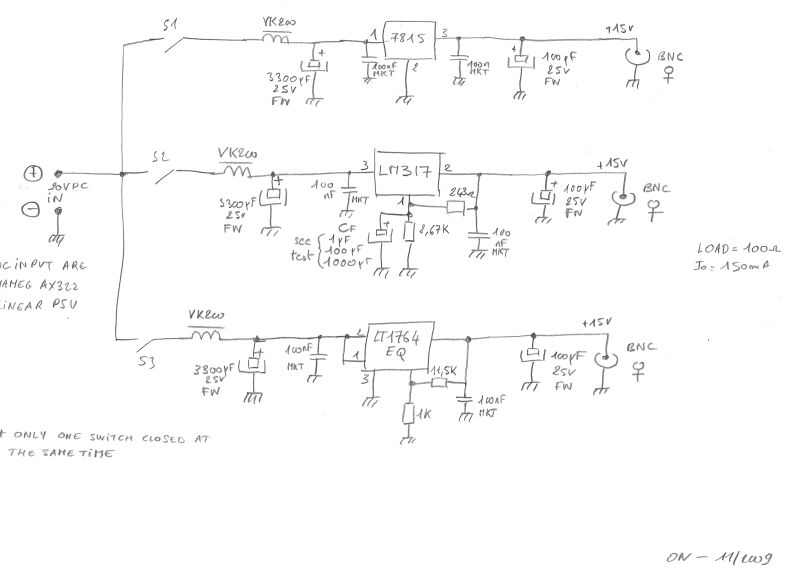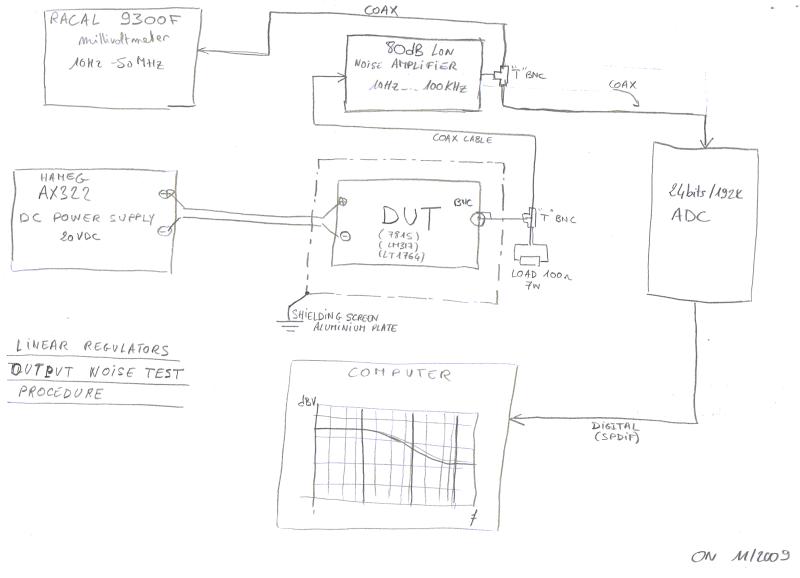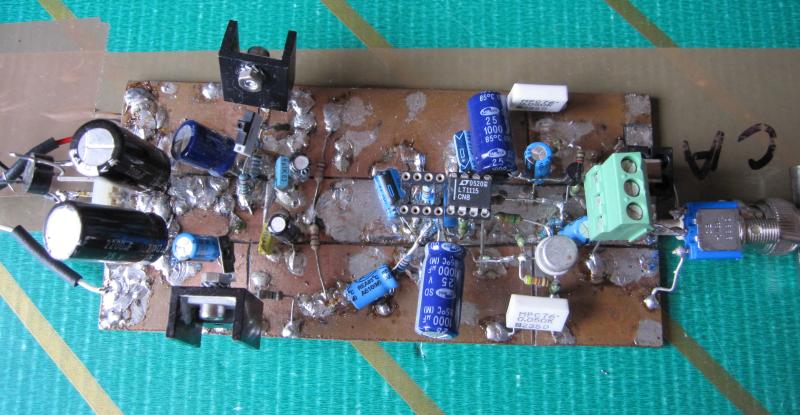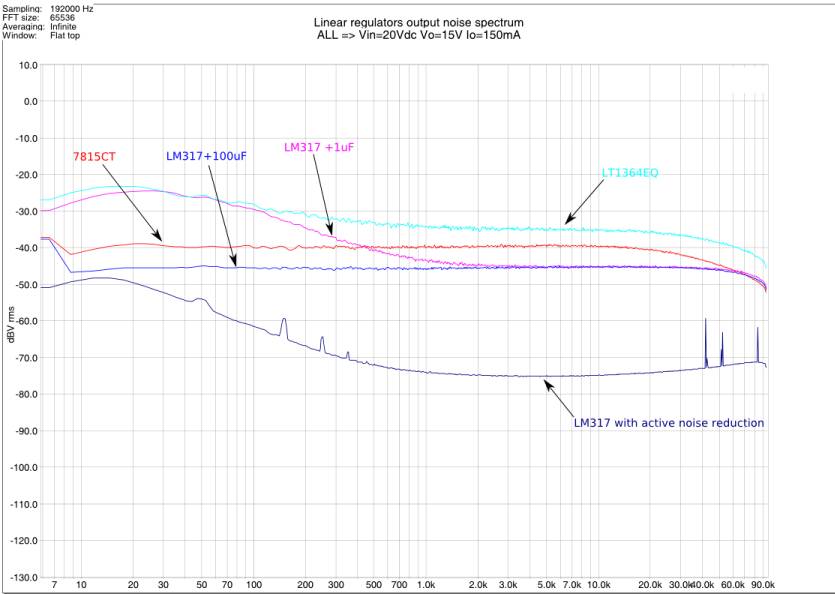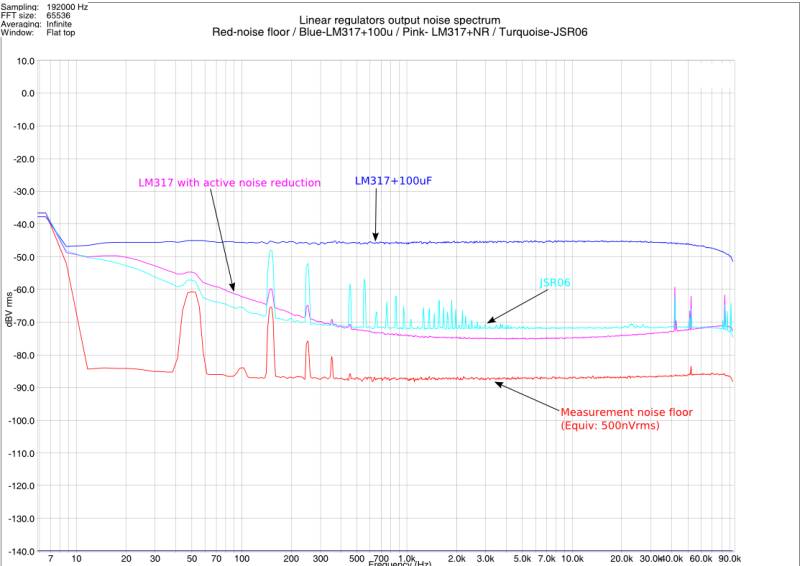Hello,
After this discussion and for my own interest, i have decided to make some noise measurements for differents voltage regulator.
The three tested voltage regulators are :
LM7815CT fixed 15V regulator (ON semi, old Motorola) in TO220 package.
LM317 positive adustable regulator (STmicro) in TO220 package too.
LT1764EQ positive adjustable "low noise" regulator (Linear Tech) in D2PAK package.
All of those voltage regulators have been welded in a copper board with decoupling capacitors, as you can see in the schematic below:
To make those measurements, i used an home made instrument (yes, DIY!).
It's a low noise high gain amplifier with band-pass filtering (10Hz-100kHz ).
The amplifier gain is 80dB (10000x) in frequency range, and it's own noise is only 500nVrms (-127dbVrms), with it's input shorted by a 50Ohms plug.
(This amplifier is fully decribed in the AN83 from Linear Technology).
Then, i used my external audio A to D converter for compute and display the noise spectrum.
The ADC is calibrated, and the spectrum is directly displayed in dbV (0dbV = 1Vrms, -60dBV= 1mVrms.)
The sampling rate of the ADC is 192kHz(so ~90kHz max allowable signal), it is good for a measurement bandwith of 10Hz-100kHz.
Below, the brief description of the measurement procedure :
The FFT software display the averaged noise spectrum and the RMS value.
At verification purpose, the rms value computes by the sofware is always compare with the measurement done by the 9300F millivoltmeter.
For finding the real noise of the regulator, now i must add 80dB at this value (or divide it by 10000).
Measurements results for each regulator are grouped in the table below.
Note:
Column 2 and 3 are the same value but in dBV and mV.
Same for column 4 and 5.
Column 2/3 is the measured voltage at the output of the 80dB amplifier.
Column 4/5 are the calculated equivalent output noise of the regulator (x10000 ratio).
As we can see, the LT1764 specified for low noise operation is the worse!
Without a good ripple rejection capacitor, the LM317 is not the best, but became best with a good filtering capacitor.
The 7815CT is also good.
All of those regulators have low output noise. It is unlikely that this level of noise become a problem with any audio analog designs.
Nevertheless, for the hoobyist who want to design an ultra-low noise PSU (for supply ultra low phase noise oscillator for example),
there are many active noise reduction circuits. This actives circuits allow to reduce the noise up to 40dB(100x).
Below, a second DIY board where 2 voltage regulators are used. One LM317 for +15V and one LM337 for it's opposite of -15V.
At left, you see each regulator, and at right the active noise filter section ..
With this board, the output noise result is listed in the table below.
The first result with noise reduction circuit "OFF" is roughly the same than the previous result (-7dBv).
If the NR is active, the noise become very very low, 27dB lower !..
The graph shows the noise spectrum between 1Hz to 100kHz for each regulator type and configuration
This speaks for itself.
Last year, i had bought a JSR06 "low noise DC supply board" from Per-Anders Sjöström (
sjostromaudio.com - Home).
It is a Pcb wich include positive and negative DC supply rail with very low output noise.
For the fun , i have also make some measurements on it's output noise.
The result is nearly the same than the LM317 with noise reduction.
The resulting spectrum is illustrated in the graph below.
In red, i have add the noise floor spectrum of the measurement system.
It's level is down to 500nVrms reffered to input in the measurements bandwidth.
I hope some of this measurements help to clarify some preconceived idea about noise issues.
Frex.






